|
To the Quiver Trees
Southwards through the Wastelands
From Sesriem, I chose the little frequented C27 road, via which I would reach the B4 paved road to Aus within a few days. The road was extremely bad and my hands especially had a hard time. In the evening, I felt like a member of the Sobèak’s Socialist Labor Brigade who had been digging for the whole day with a pneumatic drill down a mine, to beat the district record in honor of the 18th Congress of the Communist Party. The exhausting journey was balanced by the beautiful landscape in the Namib Rand Nature Reserve. Plenty of antelope live there, herds of zebra roam the area, allegedly also giraffe (I did not see any). And eight Black Rhino were relocated here—I would not have wanted to meet any of those.

[C27 30 km from Sesriem] Entrance to Namib Rand Nature Reserve over the cattle grid
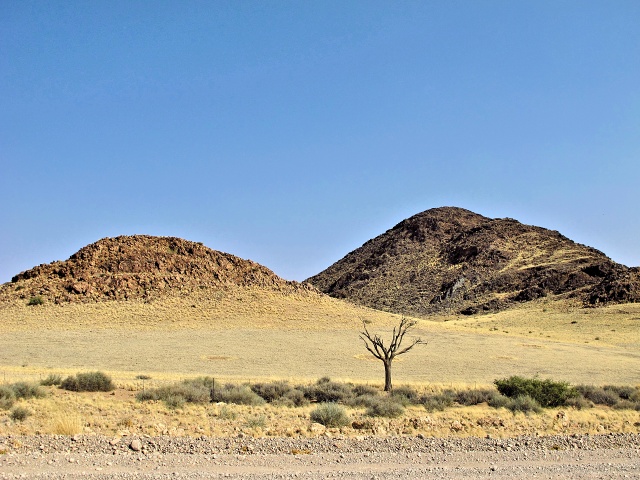
[C27 30 km from Sesriem] Some of the hills look like a cluster of poured boulders

[C27 22 km from Sesriem] Le Mirage – accommodation and spa
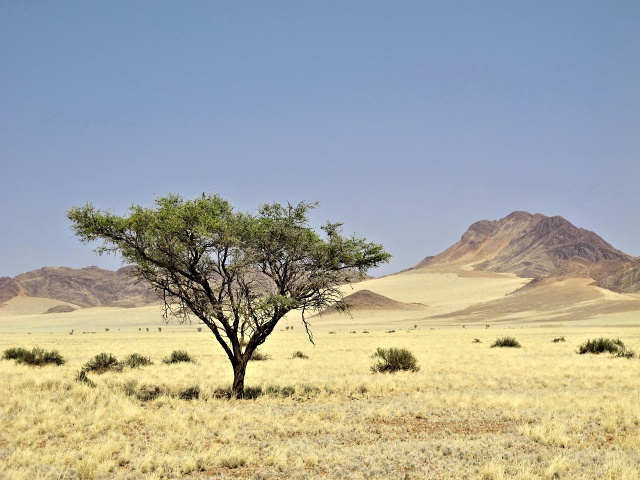
[C27 30 km from Sesriem] Sporadic trees enliven the landscape
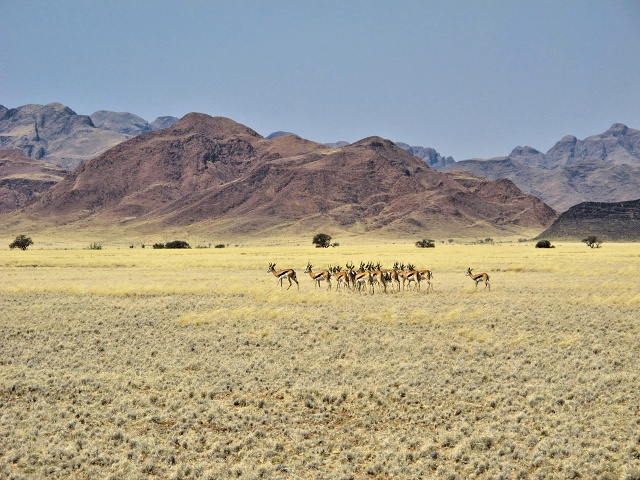
[C27 35 km from Sesriem] A Springbok herd

[C27 45 km from Sesriem] Hills resembling pyramids
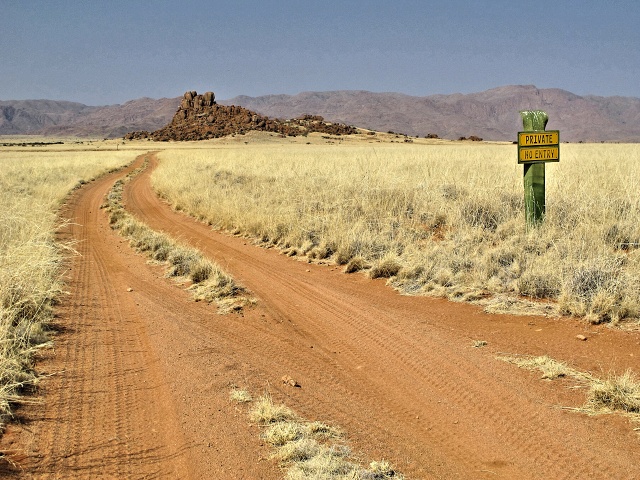
[C27 60 km from Sesriem] The interesting rock formation is inaccessible – private property – entry forbidden
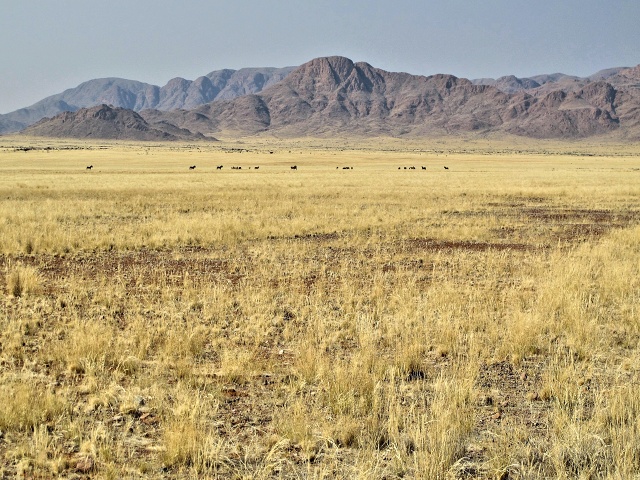
[C27 65 km from Sesriem] Herds of zebras graze on the plain
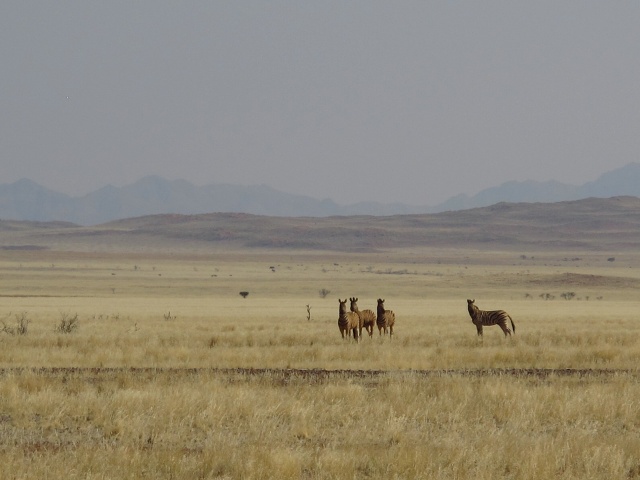
[C27 65 km from Sesriem] Zebras watch me suspiciously while ignoring passing cars
Cheating Map
I found two life-saving points on the map – campsites at a distance of about 50 and 90 km. The morning headwind was so strong that I had to push the bike for several kilometers on flat ground. So I chose the closer option. But oops, there was no lodge or campsite! It was the first time that a map had tricked me. Well, I would pedal some more and trudge on to the second option – Wolwedans Lodge and Camp. Although it existed, it was 20 km from the road and the track was definitely very inconvenient for a loaded bike. It was clear that that night would have to be spent sleeping out in the wilds. But I had no water, the landscape was barren and without any settlements, and cars passed by only at long intervals. I lowered myself to stop every passing car – I waved at them with my empty bottles to make it clear. In this way, I collected about four liters of water. With this supply, I would survive the night and the start of the next day. But hygiene would have to suffer.
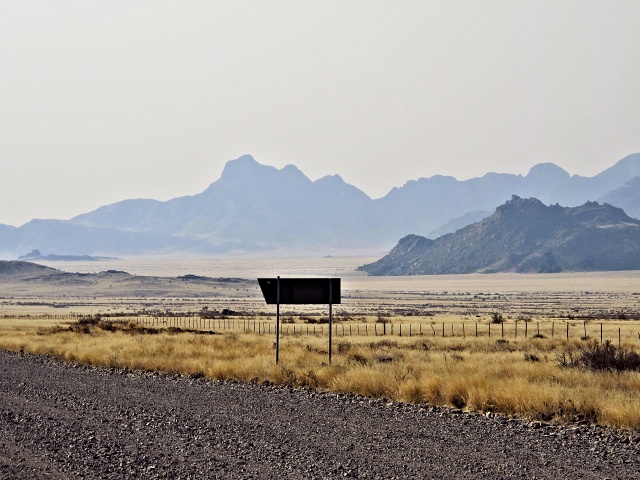
[C27 70 km from Sesriem] Time to find a place to sleep as it's getting dark
It was getting dark, so I thought that I would make my bed somewhere around the next bend, one kilometer ahead. However, a small farmhouse appeared around the bend. I cycled there, explained the situation to the owner and that I would pay him for camping there. He was quite a young black man, my money enticed him, but still he repeated that he was not equipped for it. So I went into the yard, where there was a water tap and a flat piece of ground. I explained to him that I did not need anything else. I gave him a hundred, he was happy and so was I. Classically I had to disassemble and blow out the cooker, but I had already got used to it, only the filthy hands still bothered me. I cooked one of the most nutritious combinations – beans and beef. During the day I usually ate almost nothing, only if I had some fruit and vegetables. This time I'd had supplies and in the afternoon had eaten two tomatoes and one apple left over from Etosha. But by the evening, I was already suffering from hunger.
When I lay down, the wind started to blow as strongly if a hurricane was approaching. The tent was not pegged down properly, I could not stick the pegs into the hard ground. I weighed it down with my own weight. At times, the tent poles slapped against my cheek, but still I fell asleep. The storm stopped sometime after midnight and in the morning fortunately there was no trace of the wind.
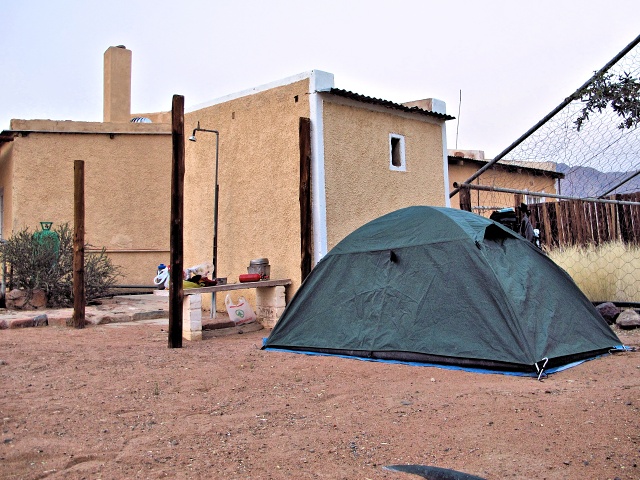
[Toekoms] Overnight in the backyard of a small farm

[C27 90 km from Sesriem] Slight improvement in the road compared to the previous day, surroundings still beautiful
No Problem in Betta
At first it seemed that the road was going to be as miserable as the previous day. Several times I had to push the bike in deep sand on flat ground, but about 20 km further on, it improved. The quality of the dirt roads in Namibia often changes abruptly, the bad sections are fortunately quite short. The surface nearly always changes after a cattle grid (a pit in the road, covered with a grid of rails to prevent animals from straying on to another piece of land).
It was a Sunday and there was some bikers' event with about 40 of them passing me – each one of course honking and waving. Indeed, we were in the same two-wheeled boat. A motorcyclist who had problems and was fixing his power-packed BMW next to the road was rather perplexed by my question as to whether he needed any help. After 60 km, I arrived at Betta, which is the crossroads to Schloss Duwisib Chateau about 30 km away. So I skipped that attraction.
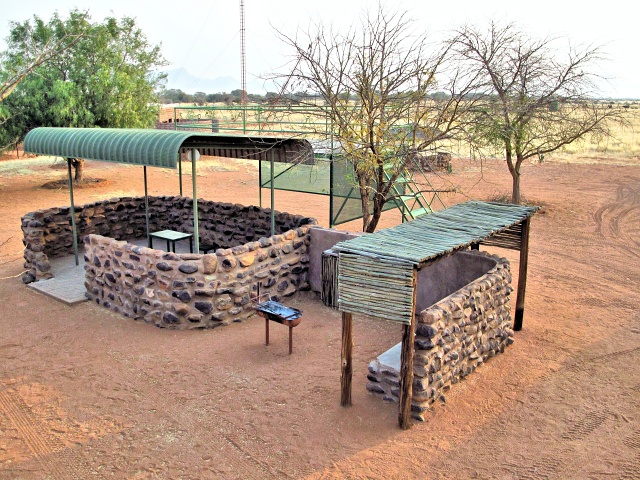
[Camping Betta] Intelligently designed camping sites – shade, table and chairs, water, screened carport
I stayed in the campsite next to the gas pump. After all, there was nothing else there except two houses. The campsite, however, was magnificent, completely meeting my needs. Large tent sites enclosed by one-meter high walls, a table and chairs, with a place for cooking and a sink with running water next to it. In addition, there was a shade canopy for the car and a deck above it, where it was possible to erect a tent or just take in the distant view. Again, I appreciated my self-supporting tent that need not be anchored by pegs and therefore I could pitch it on the concrete inside the area enclosed with a wall. In this way, I avoided the pestering wind. I washed my cycling clothes. There was even a wash line with pegs and the clothes dried within an hour in the strong wind. Later, I bought a bottle of red wine at the gas station, despite the fact that it was a Sunday and there were not supposed to be any alcohol sales. Then I just relaxed, processed my photos, wrote in my diary and fell into bed, pleasantly intoxicated. I was the only visitor in the camp, so they had heated the washing facilities in one hut and I used its bathroom and toilet. The large washroom with toilets was also open, but the water was only lukewarm in there, with which an esteemed guest would not have been satisfied.
I had a nice chat with the owner, a good-looking blonde of about 35. By the way, she had visited Prague and praised her stay there. I told her about my very negative experience with the State-operated camp (NWR) in Sesriem. She said, "If I had been running it, everyone would have been satisfied." Yes, I believed her.
In the morning, I failed to light the cooker. Fortunately, gas cookers were freely available for the huts so it was not a problem then. But it probably would be later. So I headed off quite early, relaxed and full of enthusiasm. And I needed it. First of all, a poor road covered in sand, then a battle with sizeable hills. In addition, nice delays because of my own stupidity.
Needle in a Haystack
I stopped to take photos in the veld (bush) about 40 meters from the road. I returned to the bike and could not find my spectacles anywhere. I usually put my glasses into the back pocket of my cycling outfit and they had obviously fallen out somewhere. First I searched in places where I thought I had been walking. No luck. Although I have spare glasses, I did not want to leave those there. So I started a systematic search. I marked the beginning and end of the searched area on the road with piles of stones, so that I could also see them from a distance. Then I searched the area in strips the width of my outstretched arms. I ruffled through tufts of yellow grass thoroughly with my hands, hoping that no snake, scorpion or other beast would bite me. I succeeded only after half an hour, and since then, before photographing, I always put my glasses into a pocket with a zipper.
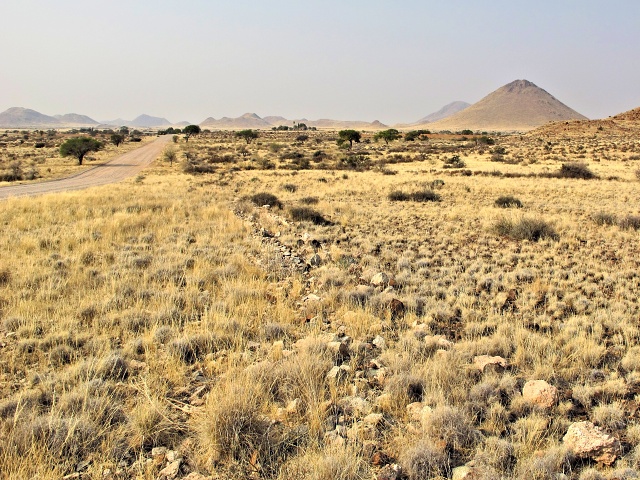
[20 km south of Betta] While photographing, I drop my glasses in the bush, followed by a demanding search
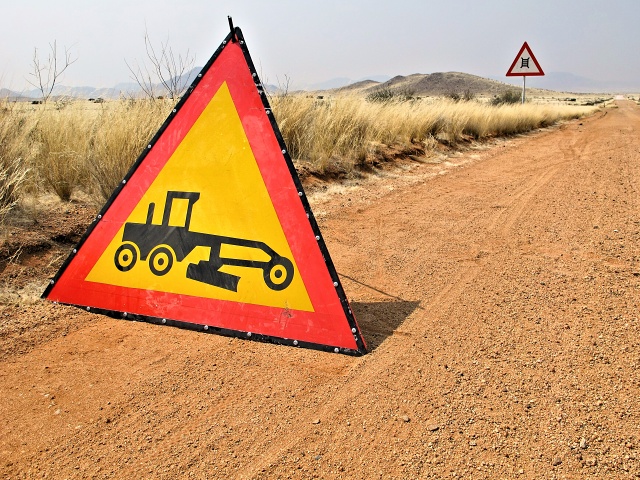
[40 km south of Betta] I love this brand, seeing it for the second time here
Tourist Attraction
Yes, I was undoubtedly a tourist attraction. I had not met any long-distance cyclists there so far and, judging by the reactions of passing motorists, currently there were none. Passing cars almost always reacted in some way– waving, honking, flashing lights. Many drivers stopped to photograph me, or to have a joint photo taken with me. It often happened that they brought me water or some other drink straight from their car and offered me food, or at least asked if I needed anything. On principle, I refused everything, except in rare cases when I actually needed it. I am exceptionally proud of how well organized I am. However, there were the exceptions – some Czechs driving from the opposite direction stopped, chatted, took photos, but would not even have dreamed of asking if I needed anything. Well, we Czechs know that we are a resilient nation and that we can manage even without foreign aid.
The Hobo Image must Disappear
Fairly tired after a mountain stage of more than 100 kilometers, I arrived at Helmeringhausen, where the campsite is part of quite a posh hotel. I went to the reception, not even taking off my helmet. The stylish lady told me with a smile that the campsite was full. I started to argue that I could fit in anywhere with my small tent, but she said that the problem was concerning the showers and toilets. She had a group (6 people) in the camp already and the camp had to maintain a certain standard, and, in addition, I had no reservation – simply telling me to get lost! An absurd situation, a crossroads in the wilderness with only one hotel and store, and she was refusing a deal. Well it was a battle. I finally got through to her that I wanted to have dinner there as well (which I wanted because my cooker was not working) and she softened a bit and said she would ask the group if they would mind my presence. And I knew that I had won. There were the three cars of the Danes whom I had met along the road. In addition, I had spoken to them in the local store where we were buying beer. One of them was a teacher who had often been on exchange teaching jobs in Hradec Králové and skiing in the Giant Mountains and he was excited. But it was clear to me that the hobo-type appearance had to disappear. Dusty and sweaty clothes were bad enough. I decided to shave as soon as possible and to keep only a standard beard.
Bethania
In the morning, I could again not persuade the cooker to work. This time the problem was in the air pump, which was not putting any pressure into the fuel bottle. Instead of coffee and tea, I had cold water, so I did not eat much either. Originally I wanted to go to Aus and to the seaside at Luderitz, but under those circumstances, it made no sense. I decided to cycle as fast as possible to Keetmanshoop, where I could hopefully buy a new cooker. If not, I would have to go shopping in Windhoek, where there were outdoor-living stores. I speeded up from a slight hill towards Bethania on a very good dirt road, where the paved road began. I was hungry, so I worked hard so as to be able to eat soon. In Bethania, I found that another campsite was about 80 km away (Seeheim), but even they were not sure about it.

[Bethanie] An ultra-modern church
I stayed in Bethania in a very pleasant campsite, which was part of the hotel. I ordered fish for lunch at an incredibly low price at a roadside café. And because they did not have any beer, they let me bring in a big bottle of beer, bought at the liquor store across the street. While cycling, I came up with the idea that the sealing ring had perhaps fallen off in the cooker's pump and that the pump somehow had to be dismantled . After a few attempts, I succeeded and the pump, and therefore the whole cooker, was put back into operation again. Moreover, the hotel owner let me use the Internet in her office and I finally downloaded the instructions and in the evening thoroughly cleaned the cooker, according to them. After that, the cooker functioned like a welding machine, really fast. I believe that if the rubber piston in the pump lasted, finally everything would be in order (and other problems would occur, as happens when traveling). The problems were caused by a combination of several factors. This cooker had not been used for four years, so the inlet pipe was a bit clogged. The poor quality gas had not helped. And my strenuous efforts to put high pressure into the cooker with an ungreased pump resulted in a pulled-out piston and non-functioning pump. To sum it up – I myself was to blame – as usual.
Caring Saleswoman
I was shopping in a local store and waiting to pay at the till when a nervous boy, aged about eight, pushed in front of me. Sheepishly he whispered that he wanted two cigarettes, pouring small coins from his sweaty palms. The saleswoman gave him two cigarettes and then asked him if he had something to light them with. And she also sold him some matches. The boy ran out, not even taking his change, so she sent the change out to him with the next customer.
Back on the Tar
A paved road began in Bethania, first it was the narrow C14 local road. Then in Goageb it connected to the B4, which is the top class of Namibian road. Apparently, they have reserved the letter A for the highways which are not yet there. The difference in cycling was huge of course. I covered 96 km, drinking only a liter of tea and not sweating at all. I could even have reached Keetmanshoop 140 km away, but instead stayed over in a campsite at the Seeheim Hotel. This is an outpost, accessible via a 2-km dirt road from the B4. There are a railway station, a hotel, a small campsite next to it, and about two farms in the vicinity. The most interesting sections were in the vicinity of Naiams, with bizarrely shaped rocks and steep descents and climbs. Just before Seeheim, there is a long bridge over the Fish River, but nothing too interesting. After all, the Fish River Canyon is still quite far away, about 150 km.

[Goageb] B4 road, very obvious difference from dirt roads
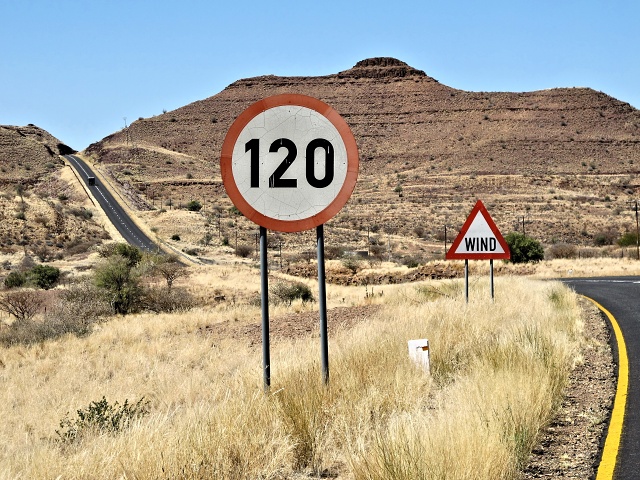
[Naiams] The road undulates quite visibly
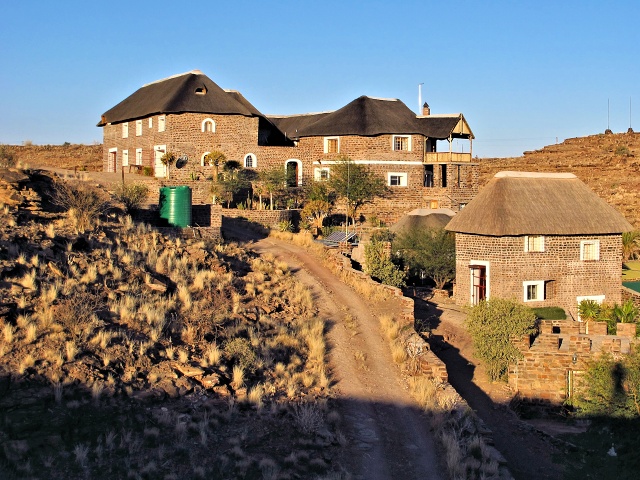
[Seeheim] The model for Seeheim Hotel was perhaps some European castle
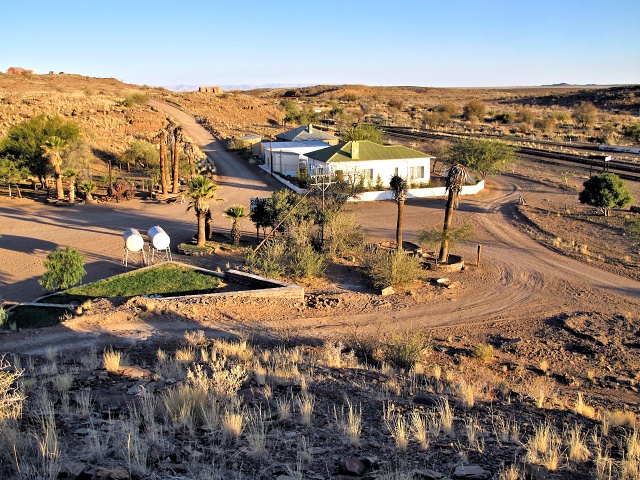
[Seeheim] Seeheim railway station
Well done! I fixed the Cooker!
Keetmanshoop is a major regional center, having 22,000 inhabitants together with its adjacent settlements. But I would not have been able to buy a camping cooker there. Whips, reins, halters and even concrete mixers were available, but there was a minimum of camping equipment. There are several supermarkets, the biggest is SPAR in which I got supplies of ready-prepared food. I put it in the fridge in the hostel and then I only needed to warm it in the microwave. I eschewed meat, as during the past days I had really eaten plenty of it. But they had several kinds of perfectly cooked vegetables and also rice and fresh tomatoes, so I was well provided for.
The hostel was cheap, and its facilities corresponded to this, but it was clean. I was the only white face there, but everybody was very nice to me and did not remark on the fact that I differed from them. I began to have a few doubts about the true purpose of this facility after I found prepared condoms in both bedside tables. I recalled Japan, where I had accidentally arrived in a brothel and was very surprised when they did not want to accommodate me there. I realized the reason only when seeing a pricelist where the prices were listed in two-hour intervals and significantly changed according to the time of day. I asked the Hostel Manager about the condoms and learned that it was for AIDS prevention and that it was mandatory there.

[Keetmanshoop] City center

[Keetmanshoop] Interesting facade
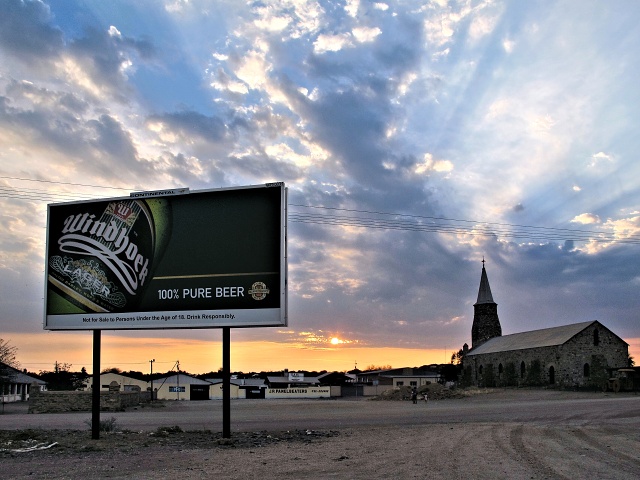
[Keetmanshoop] Finally, after a month, clouds appear and the sunset is picturesque
The First Scuffle
My instincts had become somewhat blunted by the stay in barren regions. I walked through the town, and found a hotel in which they let me use the Internet for 45 minutes for 20 N$. It was the Wi-space service of Telecom. You buy a card, scratch off the field which holds the password. You use the password the first time you access the Internet and that’s it. The connection behaves a bit nastily. After three minutes of inactivity on the Internet, the Wi-space is disconnected. But on the other hand, you do not waste unnecessary minutes by paying a flat rate.
Then, still in daylight, I returned to the Hostel. I was carrying my laptop and camera in my rucksack, when one idiot blocked my way and demanded money. I told him to stop bothering me and let me go. He began to pull the rucksack off my back, while with his other hand reaching into my shirt pocket. I started yelling “Police, Police!” and wrestled with him for the rucksack. I finally won. One boy walking by helped me, telling him to leave me alone. Nevertheless, it was my mistake, I should have got out of his way, expecting some trouble, even though it was broad daylight with many people around. I would have to start carrying a pepper spray with me all the time. I was getting close to South Africa and this was also probably to be seen in the people's behavior.
The Quiver Tree Forest
The biggest attraction of this area is the Quiver Tree forest, situated only 17 km from Keetmanshoop. Botanically these are not trees but Aloe plants (Aloe dichotoma – locally known as Kokerboom). The name arises from the fact that the Bushmen and Hottentots often produced quivers from the bark for their arrows. The plants reach up to 9 meters in height and their diameter on the ground can be up to one meter. They first bloom after 20 to 30 years. They are indigenous and that is why the local forest is such an attraction. Everything was created by Nature, no human planted or chopped down anything. The largest trees are up to 300 years old.

[Quiver Tree Forest] Trees
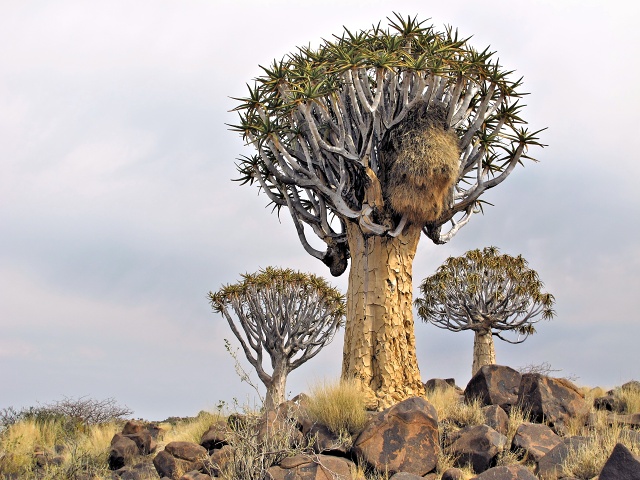
[Quiver Tree Forest] The birds settle in the trees
There is of course an entrance fee. A farm with a campsite is situated on the access road. They warned me that cheetah are often seen in the area. I only saw a large number of animals the size of rabbits and the shape of oversized hamsters – Hyrax (locally known as dassies). They had dug dozens of burrows in the meadow next to the camp and shyly peeped out of them, running over to their neighbors for a visit. The forest itself was also teeming with them.
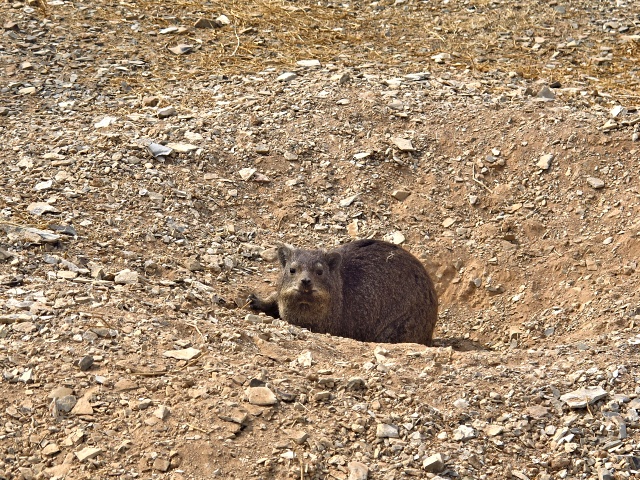
[Quiver Tree Forest] Dassies stare impudently at me from the burrows
The area is very photogenic, the impression being spoiled only by the permanently metallic Namibian sky. But I was lucky that it was slightly overcast. When the sunset turns out well here, it is an amazing sight, judging by the photos I have seen. But by sunset I was already in the Hostel to avoid danger.
Giant's Playground
The entrance fee is also valid for the playground of giants 5 km away. An astonishing number of boulders, often of prismatic shape with edges of 1 meter and more in size, are scattered over a vast area. It really reminded me of a scattered building set of a very overgrown child. To me it was depressing. Some stones looked wobbly and probably were. That is why the sign at the entrance strictly prohibits any manipulation of the boulders. If somebody leant against some of the stones, they would fall down, but who knew what consequent reaction could be triggered off. A human dimension to this place was provided by the occasional sparse quiver trees growing there in solitary isolation, as is typical for them.
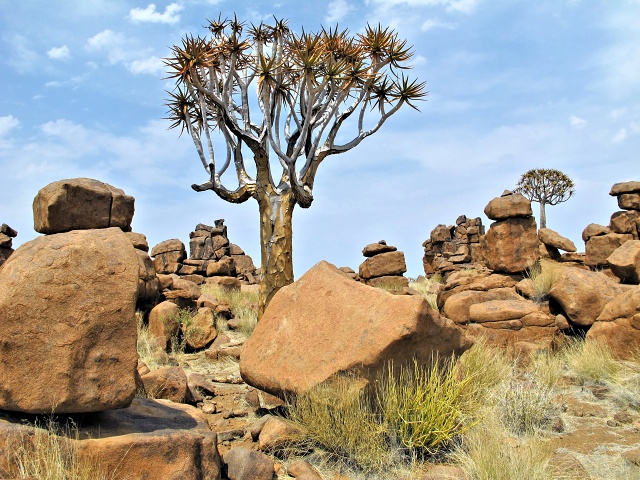
[Giant's Playground] Quiver trees enliven the huge piles of boulders
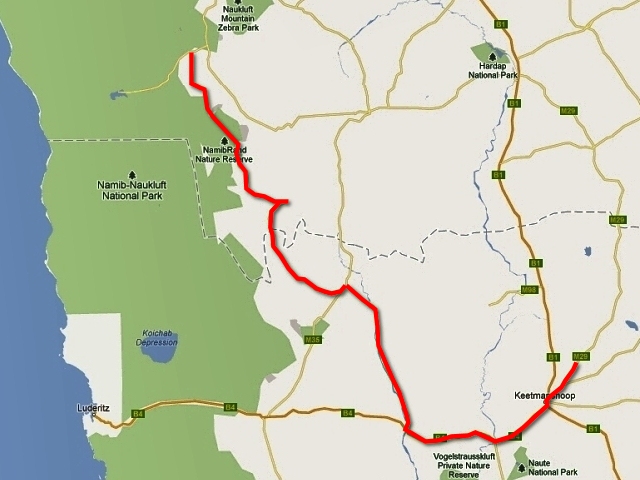
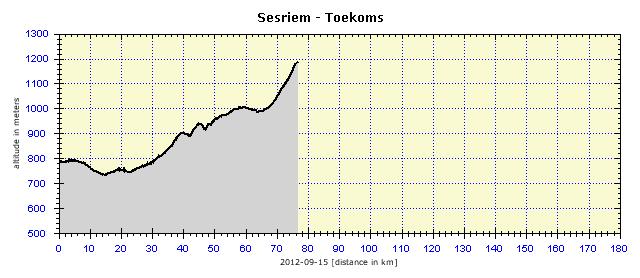

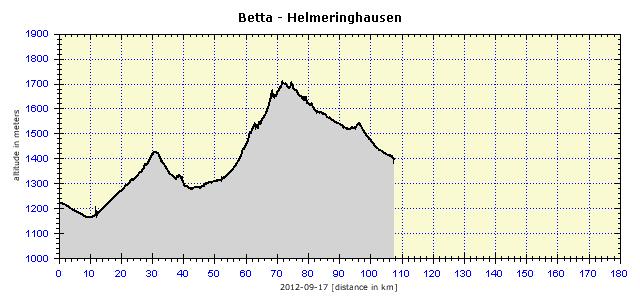
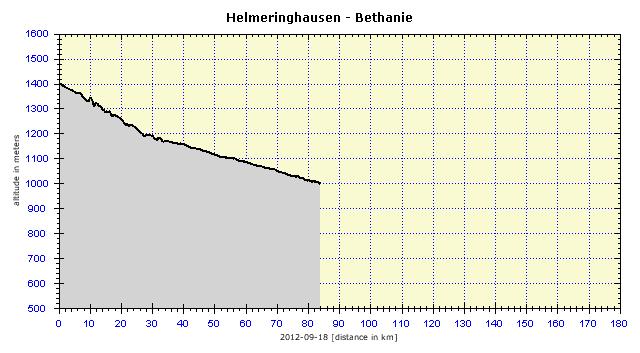
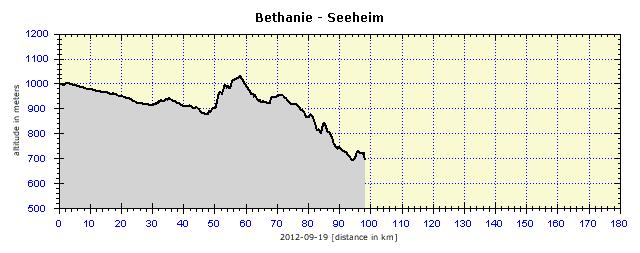


|










































